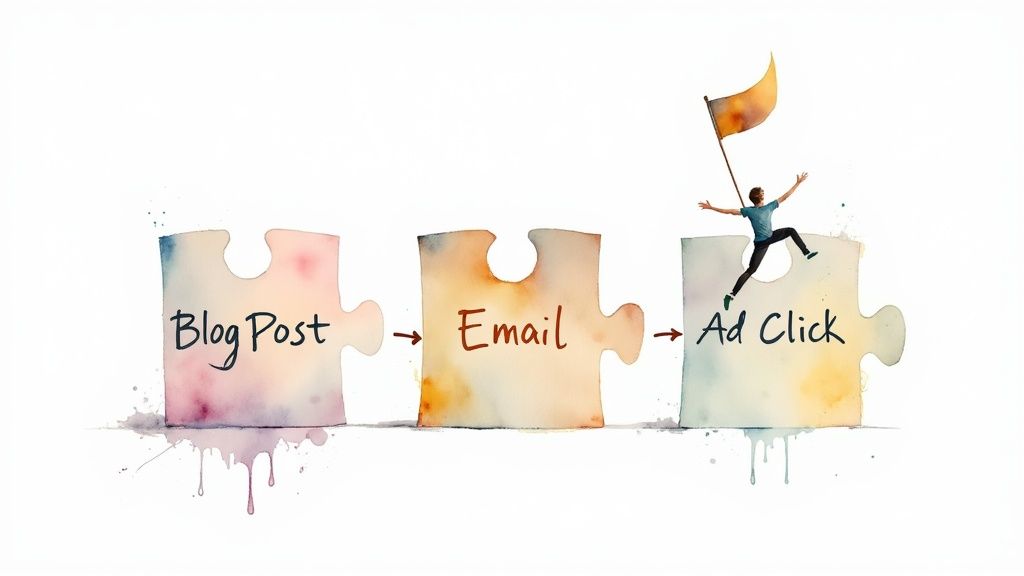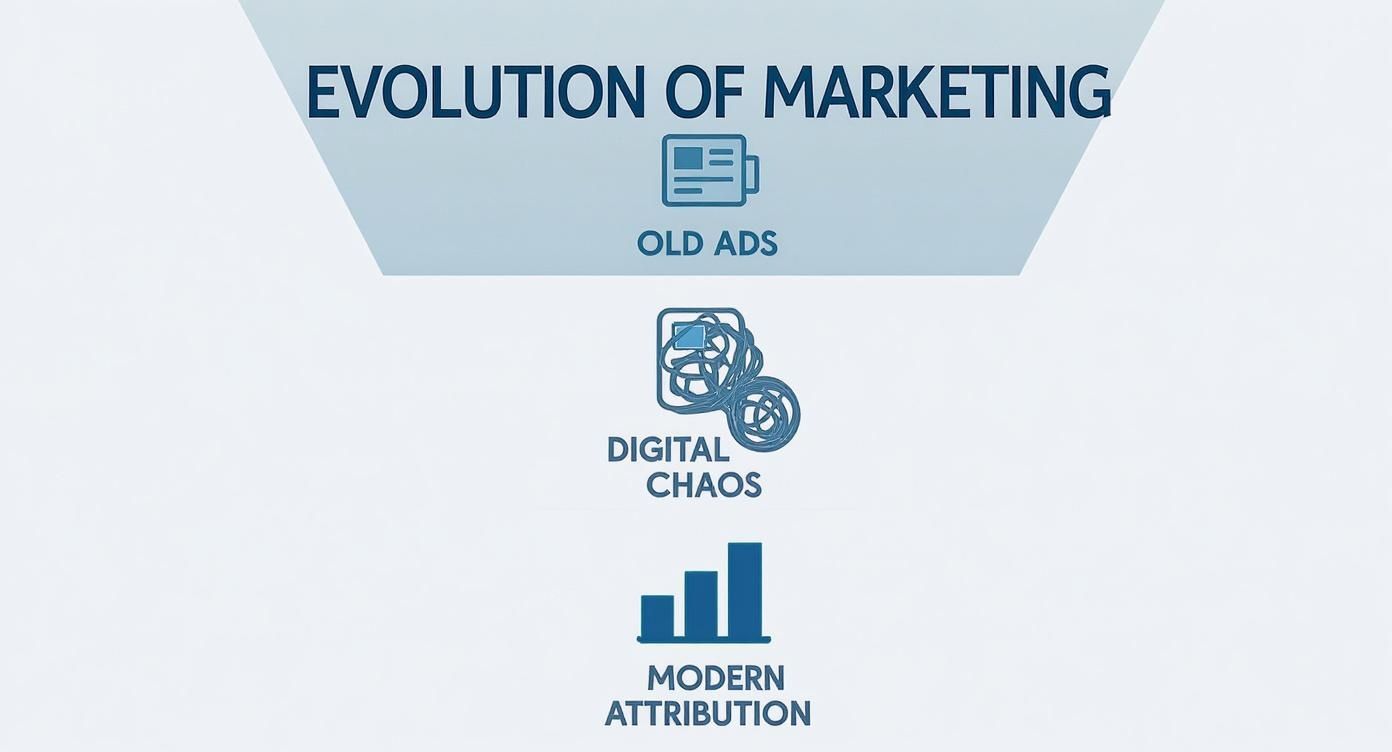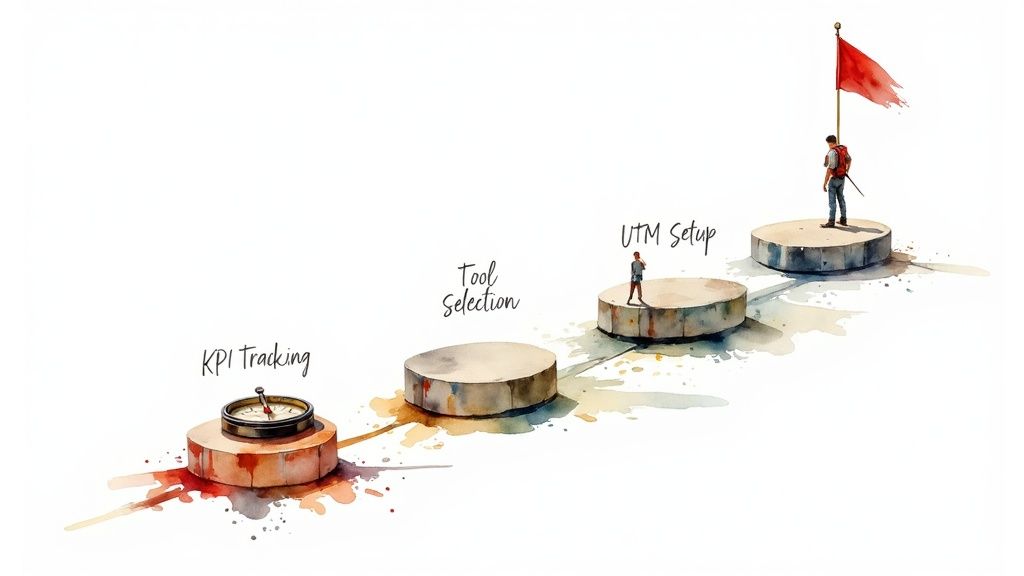Marketing attribution is how you figure out which marketing touchpoints get credit for a conversion. It’s the process of connecting the dots between all your marketing efforts and a customer's final decision to buy, so you know exactly what's working and what isn't.
Decoding Your Customer Journey With Marketing Attribution

Ever feel like you’re just guessing which campaigns are actually bringing in sales? You’re not the only one. Without a clear way to link marketing actions to business outcomes, optimizing your budget can feel like throwing darts in the dark. This is the exact problem marketing attribution was designed to solve.
Let’s think about it like a soccer team scoring a goal. It wasn't just the player who kicked the ball into the net. What about the defender who started the play, the midfielder who made the crucial pass, and the forward who created the opening? They all played a part.
Why Attribution Matters More Than Ever
Marketing attribution is like the game's official scorekeeper, assigning credit to each "player"—or touchpoint—that moved the customer along their journey. This could be anything from a blog post they read weeks ago to the final retargeting ad they clicked. To really get a handle on this, it helps to understand the basics of what is attribution modeling.
Once you start tracking this path, you can finally answer those big-budget questions with confidence:
- Which channels are really giving us the best return on investment (ROI)?
- Where should our next marketing dollar actually go?
- How do we make our sales cycle shorter and more efficient?
By swapping guesswork for hard data, marketing attribution gives you the clarity to make smarter decisions, prove your team’s impact, and build strategies that drive repeatable growth. It turns marketing from a simple cost center into a predictable revenue engine.
Even though it’s a game-changer, many marketing teams are still playing catch-up. A 2024 report found that 76% of marketers globally either have attribution capabilities or plan to get them within the next year. It’s a clear signal that the industry is moving toward data-driven accountability, but it also shows just how many teams are still flying blind.
Attribution helps tackle some of the most persistent headaches in marketing. Here’s a quick look at common problems and how attribution provides the solution.
Common Marketing Problems Solved by Attribution
| Marketing Problem | How Attribution Solves It |
|---|---|
| Uncertain ROI | Directly links marketing spend on specific channels to the revenue they generate, providing clear ROI figures. |
| Wasted Ad Spend | Identifies underperforming campaigns and channels, allowing you to reallocate budget to what actually works. |
| Long Sales Cycles | Highlights the most effective touchpoints that accelerate the customer journey, helping you optimize for faster conversions. |
| Siloed Channel Data | Creates a unified view of the customer journey across all channels, breaking down data silos between teams. |
| Difficulty Proving Value | Provides concrete data to demonstrate marketing’s direct contribution to sales and overall business growth. |
Ultimately, implementing a solid attribution model is about moving beyond vanity metrics and focusing on what truly drives the bottom line. It's the key to unlocking smarter, more efficient marketing.
How We Moved Beyond Last-Click Thinking
To really get why modern marketing attribution is so important, it helps to look back at how we got here. It wasn't that long ago that marketing felt a lot like guesswork—a "spray and pray" approach, if you will. Businesses would throw money at newspaper ads, billboards, and TV commercials, crossing their fingers that the right people would see them and decide to buy.
Measuring the impact was foggy at best. You might track a coupon code or have cashiers ask, "How did you hear about us?" but connecting a specific ad to a final sale was nearly impossible. The customer's journey was a black box, leaving marketers to operate on broad hunches instead of hard data.
The Digital Explosion
Then the internet came along and flipped the script. Suddenly, marketers weren't just dealing with a handful of channels; they were juggling an explosion of new ways to reach people.
- Search Engines: Customers started their own journeys, actively looking for what they needed.
- Email Marketing: Brands could finally build a direct line to their audience, nurturing them over time.
- Social Media: Entirely new worlds opened up for discovery, conversation, and community.
This digital shift shattered the old, linear path to purchase. A customer might now see a brand on Instagram, search for it later on Google, click a retargeting ad on a news site, and finally buy after getting a promo email. The journey became a web, not a straight line.
The old ways of measuring just couldn't keep up. Relying on the final touchpoint before a sale—what we call last-click attribution—was like giving all the credit for a Super Bowl win to the player who scored the final touchdown, completely ignoring the quarterback, the offensive line, and the coaches who made it happen.
This simple realization kicked off a massive shift in how we think about marketing. The real push for what we now call digital marketing attribution started gaining steam in the late 90s and early 2000s, right as these new channels were taking off. By 2005, an estimated 65% of major digital-first companies were already trying out more sophisticated models to truly understand their marketing efforts. You can read more about the historical importance of marketing attribution to see just how far we've come.
This wasn't just a fleeting trend; it was a flat-out necessity. To make smart budget decisions and figure out what was actually working, businesses had to see the whole picture. That demand for a complete, honest view of the customer journey is exactly what drove the creation of the multi-touch attribution models we rely on today.
A Look at the Core Marketing Attribution Models
Okay, now that we’re on the same page about why you need to see the entire customer journey, let's get into the how. This is where marketing attribution models come into play.
Think of these models as different sets of glasses for looking at your data. Each pair brings certain touchpoints into sharp focus while others might fade into the background. The right model for you depends entirely on what you’re trying to figure out about your marketing efforts.
The infographic below really nails how far we've come—from the old "spray and pray" days to the smarter, data-driven world we're in now.

It’s a great visual for the shift from guessing which billboards worked to making sense of the beautiful chaos of digital marketing. Modern attribution is what brings clarity to that chaos.
Generally, attribution models fall into two big buckets: single-touch and multi-touch. Each one gives you a totally different angle on what’s actually driving your conversions.
Single-Touch Attribution Models
Single-touch models are the definition of keeping it simple. They give 100% of the credit for a sale to just one marketing interaction. While they’re a breeze to set up, they offer a pretty limited, almost tunnel-vision view of the customer journey.
First-Touch Attribution: This model is all about the first impression. It hands all the credit to the very first interaction a customer had with your brand. Think of it as rewarding the channel that got you the "first date." If someone discovers you through a blog post and then converts a month later, that blog post gets all the glory. It’s perfect for figuring out which channels are your best lead generators.
Last-Touch Attribution: On the flip side, this model gives all the credit to the final interaction right before the conversion. It’s all about the "final push" that sealed the deal. If a customer clicks a retargeting ad and buys immediately, that ad gets 100% of the credit, no matter what came before. This model is great for identifying your most effective closing channels.
While these models are straightforward, they oversimplify the journey. They completely ignore all the valuable interactions in the middle—the ones that build trust and nurture a lead from curious to convinced.
A single-touch model is like crediting only the author of a book's last chapter for its success. It tells an incomplete story, ignoring the critical plot development and character building that happened in the earlier chapters.
This major blind spot is exactly why multi-touch models were created. They aim to paint a more realistic and balanced picture by spreading the credit across multiple touchpoints.
Multi-Touch Attribution Models
Multi-touch models get it. They understand that a single conversion is usually the result of several interactions. By distributing credit across the customer's path, they give you a much richer understanding of what's truly working.
Here's a quick rundown of the most common models and how they stack up against each other.
Comparison of Marketing Attribution Models
| Model Type | How It Works | Best For | Potential Pitfall |
|---|---|---|---|
| Linear | Spreads credit evenly across all touchpoints. | Getting a simple, holistic view of all contributing channels. | Treats every touchpoint as equally important, which is rarely true. |
| Time-Decay | Gives more credit to touchpoints closer to the conversion. | Businesses with longer sales cycles, emphasizing closing channels. | Can undervalue crucial top-of-funnel awareness efforts. |
| U-Shaped | Credits the first touch and the lead conversion touch most heavily. | Valuing both initial awareness and the final decision-making steps. | The middle touches that nurture the lead can get overlooked. |
Let's dive a bit deeper into what these actually look like in practice.
Linear Attribution
The Linear model is the most democratic of the bunch. It assigns equal credit to every single touchpoint along the way. If a customer saw a social media post, opened an email, and then clicked a paid search ad before buying, each channel would get 33.3% of the credit.
It's a solid choice for getting a baseline view and making sure no interaction is completely ignored. The big downside? It assumes a quick glance at a social post is just as valuable as someone engaging with a detailed case study, which often isn't the case.
Time-Decay Attribution
The Time-Decay model works on the assumption that the closer an interaction is to the sale, the more important it was. Touchpoints from weeks ago get a little credit, while the one from yesterday gets a lot more. It's a momentum-based model.
This approach is really useful for companies with longer, more considered purchase cycles. It helps you see which actions are actually accelerating a deal toward the finish line.
U-Shaped (Position-Based) Attribution
The U-Shaped model is a popular hybrid that tries to give you the best of both worlds. It gives the most credit to two key moments: the very first touch (the one that sparked awareness) and the touchpoint that created the lead or directly led to the conversion.
A common setup gives 40% of the credit to the first touch, 40% to the lead-creation touch, and sprinkles the remaining 20% across all the interactions in between. This balanced approach is why so many marketers love it—it values both the start of the journey and the final, decisive action.
Choosing the Right Attribution Model for Your Business
Knowing the theory behind each model is one thing. Actually putting one to work to get results? That’s a whole different ballgame. The best marketing attribution model isn't the most complicated one—it’s the one that fits your business like a glove. There’s no single "right" answer for everyone, but there is a right answer for you.
So, how do you find it? It starts with asking some honest questions about your business. You don't need a data scientist or a complex algorithm. What you need is a clear picture of your goals, how long it takes to make a sale, and the channels you're using to talk to customers. For companies working with a tight budget, this is one of the most valuable marketing tips for small businesses out there because it forces you to spend smarter.
Align Your Model With Business Goals
First things first: what are you actually trying to achieve? Are you hunting for brand new leads, or are you trying to nudge prospects who are already in your orbit across the finish line? Your main objective will tell you which touchpoints you should care about the most.
For Brand Awareness: If your mission is to get your name out there and introduce your brand to people who've never heard of you, the First-Touch model is your best friend. It gives you a crystal-clear look at which channels are doing the heavy lifting at the top of your funnel. It answers the question: "Where are people discovering us for the very first time?"
For Lead Conversion: On the flip side, if your pipeline is full but you're struggling to close deals, a Last-Touch model can be surprisingly powerful. It cuts through the noise and shines a spotlight on your best "closers"—the channels that deliver the final knockout punch.
Factor In Your Sales Cycle Length
How long does it take for someone to go from "Who are you?" to "Here's my credit card"? This is a huge piece of the puzzle. An impulse buy on an e-commerce site is a world away from a B2B software deal that takes six months and a dozen meetings to close.
A short sales cycle, like you’d see in most e-commerce businesses, often plays nicely with simpler models like Last-Touch because the customer journey is quick and to the point. But a long, drawn-out sales cycle with multiple decision-makers needs something more nuanced. That's where models like Time-Decay or U-Shaped come in, as they do a much better job of capturing that thoughtful, extended decision process.
A Time-Decay model, for instance, is perfect for understanding momentum in a multi-month sales process. It gives more credit to the touchpoints that happened right before the deal closed, helping you see what really accelerated the decision.
Evaluate Your Channel Complexity
Finally, take a look at your marketing mix. Are you running a single paid ad campaign, or are you juggling organic search, social media, email marketing, and live events? The complexity of your strategy should match the sophistication of your model.
If you're just starting out with one or two channels, a Last-Click model is a perfectly fine place to begin. It's simple, actionable, and you won't get lost in the data.
But if you're running a multi-channel symphony designed to nurture leads over weeks or months, you'll need a multi-touch model like Linear or U-Shaped. These models give you the full picture, preventing you from accidentally slashing the budget for a vital mid-funnel channel just because it wasn't the very first or very last click. The key is to match your model's complexity to your marketing's complexity.
Putting Your Marketing Attribution Strategy Into Action

Alright, you've got the theory down. Now it’s time to roll up your sleeves and actually put a marketing attribution strategy into practice. This part can feel like a huge hurdle, but it doesn’t have to be some massive, overnight project.
The secret is to start small, build a solid foundation, and add layers of complexity as you go. A phased, practical approach is way more likely to stick—and deliver real results from day one.
Your absolute first move? Get your data hygiene in order. Seriously, this is non-negotiable. Without clean, reliable data, even the most sophisticated attribution model is just spitting out garbage insights. This all starts with standardizing your UTM parameters.
UTMs are just little tags you add to your URLs to tell analytics tools where your traffic is coming from. If your tagging is all over the place—like using "Facebook" for one campaign and "facebook.com" for another—your reports will be a fragmented mess. Sit down and create a clear, documented naming convention for every single campaign. This is the bedrock of accurate tracking.
Building Your Attribution Toolkit
Once your data is clean, you need the right tools to make sense of it all. Good news: you don't need a six-figure software suite to get started. Many businesses can pull incredible insights from tools they already use.
- Google Analytics: This is the perfect place to begin. It comes with several free, built-in attribution models (like First-Click and Last-Click) that can give you immediate, actionable feedback on how your channels are performing.
- Specialized Platforms: As you get more advanced, you might look into tools like HubSpot or other dedicated attribution software. These platforms unlock more advanced multi-touch models and deeper integrations, painting a much richer picture of the entire customer journey.
The goal isn't to buy the fanciest tool on the market. It's to pick the one that actually fits your current resources and business goals. Start simple, master the basics, and then scale up your tech as your strategy gets more sophisticated.
Setting Clear Goals and Overcoming Hurdles
Before you even think about diving into the data, you need to define what success actually looks like. Your Key Performance Indicators (KPIs) have to be tied directly to your business objectives.
Are you obsessed with Cost Per Acquisition (CPA)? Maybe Return on Ad Spend (ROAS) is your north star? Or is it all about Customer Lifetime Value (CLV)? Nailing down these benchmarks gives your analysis a clear purpose.
Of course, no plan is perfect. You're going to hit some bumps in the road. Getting buy-in from other teams is a classic one. Sales and marketing absolutely have to agree on what a "lead" or "conversion" actually is. Clear communication and shared goals are the only way to break down data silos and make sure everyone trusts the insights you're uncovering.
Another common challenge is connecting the dots between online and offline activities. What happens when a prospect sees you at a trade show and then converts on your website a week later? Tracking that often requires some manual data entry or a slick CRM integration, but bridging that gap is essential if you want a true 360-degree view.
A simple, practical step you can take right now is optimizing your high-intent pages. After all, you want to make sure the traffic you're tracking has the best possible chance to convert. You can learn more about crafting effective landing pages that convert to get the most out of every click. Taking these kinds of proactive steps helps turn potential roadblocks into manageable tasks.
Frequently Asked Questions About Marketing Attribution
As you start to put marketing attribution into practice, you’ll probably run into a few common questions. Getting these sorted out is the key to moving from theory to real-world results. Let's tackle the questions I hear most often.
Attribution vs. Mix Modeling
One of the biggest points of confusion is the difference between marketing attribution and Marketing Mix Modeling (MMM). They sound similar, but they operate on completely different scales.
Think of it like this: attribution is a magnifying glass, while MMM is a telescope.
Marketing attribution gets up close, focusing on individual customer journeys to assign credit to specific digital touchpoints, like an ad click or an email open. Marketing Mix Modeling, on the other hand, zooms way out to look at the big picture. It analyzes how a broad mix of factors—including offline ads, seasonality, and even economic trends—impacts sales over a long period.
Starting With a Small Budget
Good news: you don't need a pricey, top-of-the-line platform to get started. The best way to begin with attribution on a tight budget is to simply use the tools you already have.
Google Analytics offers basic models like First-Click and Last-Click completely free. Your first and most important job is to establish consistent UTM tracking for every single campaign you run. Seriously, this is the foundation. Nailing this step ensures your data is clean and will give you powerful insights long before you ever need to pay for a specialized tool.
You can find more practical strategies over on the RebelGrowth blog.
How Data Privacy Changes the Game
The marketing world is in a constant state of flux, especially when it comes to data privacy. With the phase-out of third-party cookies and tougher regulations, tracking every single step of a user’s journey has gotten harder, but it’s definitely not impossible.
This shift is actually pushing the industry toward smarter, more privacy-friendly ways to measure impact. The new game plan often involves:
- Aggregated data analysis
- First-party data collection
- Panel-based measurement
These methods help marketers figure out what's working without stepping over the line on individual user privacy.
Ready to turn attribution insights into automated growth? The rebelgrowth AI Marketing Agent can analyze your data, create campaigns, and optimize your strategy. Take control of your marketing today!
